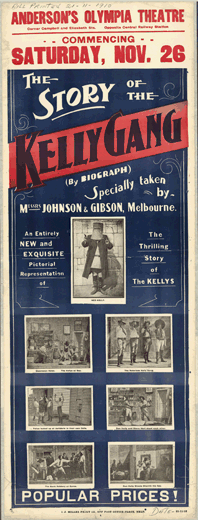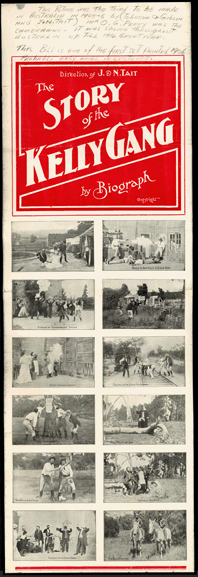 2007 Program - Reviews, credits and stills
2007 Program - Reviews, credits and stills 2007 Program - Reviews, credits and stills
2007 Program - Reviews, credits and stills

The Australian film industry produced what was probably the world's first full length feature film in 1906. The film was the Tait brothers production The Story of the Kelly Gang. It was a success in both Australian and British theatres, and it was also the beginning of a genre of bushranger stories.
In November 2006 the National Film and Sound Archive released a new digital restoration of The Story of the Kelly Gang. This restoration incorporated 11 minutes of material recently discovered in the United Kingdom. Prior to this discovery only a few minutes of footage was available. The Story of the Kelly Gang can be seen when visiting the National Film and Sound Archive in Canberra, Australian Capital Territory.
While the Australian public took a liking to bushranger stories, the New South Wales police department did not. The production of films about bushrangers was banned in 1912. The Kelly story, however, outlasted the ban and has been refilmed a number of times since.
Other well known films about Ned Kelly include: Ned Kelly (1970) starring English rock singer Mick Jagger as Ned; the Trial of Ned Kelly (1977) starring John Waters and Gerard Kennedy; the 1980 mini-series The Last Outlaw starring John Jarratt, Steven Bisley and Sigrid Thornton; and most recently the 2003 Gregor Jordan directed Ned Kelly which starred Heath Ledger.
* * * * * Images from the National Film and Sound Archive * * * * *

The Story of the Kelly Gang is the only narrative film known to have been made in Australia during 1906. It was based on the exploits of folk here horse thief, and bank robber, Ned Kelly, who, had been hanged for murder twenty years earlier. The film was made by the Tait family with the technical assistance of Millard Johnson and William Gibson. The Taits were theatrical entrepreneurs who saw commercial opportunities in narrative films.
Filming took place at the Taits' Chartersville Estate in Heidelberg, Melbourne, where the eldest family member, Charles directed filming, and Millard Johnson operating the camera. Ned Kelly was played initially by a Canadian stunt actor, and after his departure, by an understudy. Members of the Tait family took most of the remaining roles. Joe Perry's sons, Reg and Orry worked on additional scenes that were included in a reissued version of the film in 1910.
The film ran for more than hour and cost around 1000 pounds to make. This was quickly recouped during a week's trial exhibition. Its historical significance is its length, which required it to be released as a five reel feature. This was unusual at the time, as film exhibitors in the United States pressured producers to release films as one reelers.
During the Melbourne premiere of The Kelly Gang, on December 26 1906, sound effects were added. Blank cartridges were fired and coconut shells were beaten together to simulate hoofbeats. Audience response was enthusiastic, but the film aroused much critical and social comment. A report in The Bulletin claimed that the film incited a group of Ballarat children to commit a felony.
In April 1907, The Kelly Gang was the subject of Australia's first official censorship of cinema. The Victorian Chief Secretary banned screenings of the film in Benalla and Wangaratta, Victorian country towns where the real Kelly Gang had been active. From March 1907 it played all over Australia and later that year was screened in New Zealand, Britain and Ireland. However, when the film was re-released in 1910, it was banned across Victoria.
Prints of the first release of The Story of the Kelly Gang had disappeared by the Second World War. Some portions of the film were found in private collections during the 1970s, but are probably out takes or off cuts that were not seen its release form. These are now held by Screen Sound Australia.
The earliest film (The Story of the Kelly Gang) was produced in 1906, making history as the first feature-length dramatised fiction film made in Australia (and possibly the world). Only a few minutes have survived of this production, and a copy of the programme booklet, containing both extracts from contemporary newspaper reports of the capture of the gang, and a synopsis of the film, in six 'scenes'. The latter provided audiences with the sort of information later provided by intertitles, and now helps historians imagine what the film may have been like.
Its tone is one of sorrow rather than anger, describing Kelly as 'the Last of the Bushrangers', presenting the police hiding under the bed when Aaron Sherritt is shot ('This is the Only Blot on the Police'), and Curnow's action in warning the train as heroic ('Thank God, he Saved the Train'). Among the surviving images are two scenes that suggest considerable sophistication for that time. The scene of the police shooting parrots in the bush skilfully positions the shooter in the middle ground to the left of the image, firing upwards toward the far right, with the gang watching him from close foreground. The capture of Ned is shot from the viewpoint of the police, as Ned advances, an impressive figure weaving towards them under the weight of his armour and the shock of the bullets. The film was hugely successful, touring Australia for more than twenty years, and also being presented to great acclaim in New Zealand and Britain.